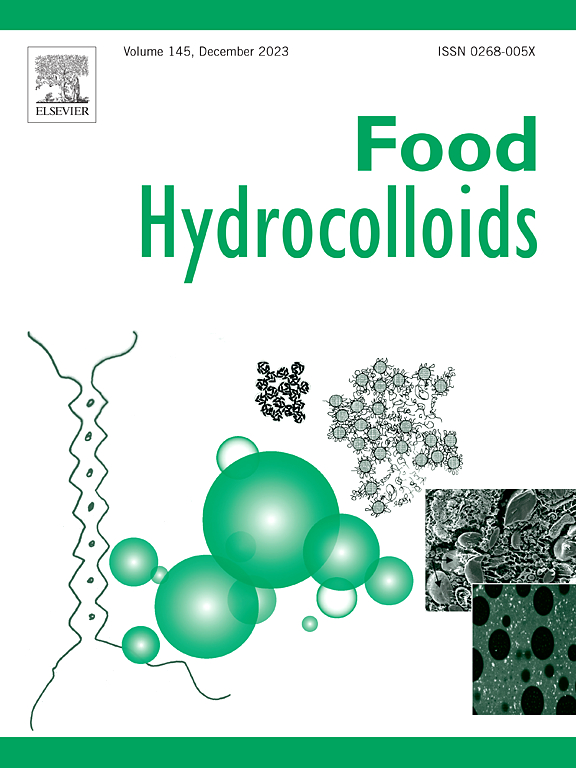Carboxymethyl chitosan/oxidized sodium alginate self-healing emulsion gels with enhanced physical stability
IF 11
1区 农林科学
Q1 CHEMISTRY, APPLIED
引用次数: 0
Abstract
This study presents a general approach for fabricating polysaccharide-based self-healing emulsion gels with superior physical stability. The emulsion gels were synthesized by crosslinking carboxymethyl chitosan (CMC)-stabilized emulsions with oxidized sodium alginate (OSA). The self-healing properties of the gels were attributed to the formation of reversible imine bonds between the primary amino groups (-NH2) of CMC and the aldehyde groups (-CHO) of OSA. Gelation occurred rapidly (20–60 s) upon mixing the CMC-stabilized emulsion with the OSA solution. Microstructural analysis revealed that the dispersed oil droplets were tightly encapsulated within an interconnected gel network. The compressive strength and rheological properties of the CMC-OSA emulsion gels were influenced by the mass ratio of CMC to OSA and the preparation parameters of OSA. Furthermore, the CMC-OSA emulsion gels demonstrated rapid self-healing at room temperature without external stimuli, along with excellent injectability. Owing to the 3D gel-like network structure and reversible interactions at the oil/water interface and within the continuous phase, the emulsion gels exhibited exceptional physical stability, including storage stability, freeze-thaw stability, pH and ionic stability, thermal stability, and centrifugal stability. This study provides a promising strategy for developing injectable self-healing emulsion gels with tunable mechanical properties and enhanced physical stability for multifunctional applications.

求助全文
约1分钟内获得全文
求助全文
来源期刊

Food Hydrocolloids
工程技术-食品科技
CiteScore
19.90
自引率
14.00%
发文量
871
审稿时长
37 days
期刊介绍:
Food Hydrocolloids publishes original and innovative research focused on the characterization, functional properties, and applications of hydrocolloid materials used in food products. These hydrocolloids, defined as polysaccharides and proteins of commercial importance, are added to control aspects such as texture, stability, rheology, and sensory properties. The research's primary emphasis should be on the hydrocolloids themselves, with thorough descriptions of their source, nature, and physicochemical characteristics. Manuscripts are expected to clearly outline specific aims and objectives, include a fundamental discussion of research findings at the molecular level, and address the significance of the results. Studies on hydrocolloids in complex formulations should concentrate on their overall properties and mechanisms of action, while simple formulation development studies may not be considered for publication.
The main areas of interest are:
-Chemical and physicochemical characterisation
Thermal properties including glass transitions and conformational changes-
Rheological properties including viscosity, viscoelastic properties and gelation behaviour-
The influence on organoleptic properties-
Interfacial properties including stabilisation of dispersions, emulsions and foams-
Film forming properties with application to edible films and active packaging-
Encapsulation and controlled release of active compounds-
The influence on health including their role as dietary fibre-
Manipulation of hydrocolloid structure and functionality through chemical, biochemical and physical processes-
New hydrocolloids and hydrocolloid sources of commercial potential.
The Journal also publishes Review articles that provide an overview of the latest developments in topics of specific interest to researchers in this field of activity.
 求助内容:
求助内容: 应助结果提醒方式:
应助结果提醒方式:


